 |
Gage County--1877 |
This is a NEGenWeb Project web page
and is presented as part of the
MARDOS Memorial Library Collection.
Gage County--1877
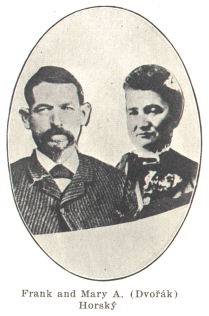
When the first half of the Otoe Indian Reservation in this county was opened to white settlers, Frank Horsky was the first to settle there. Mr. Horsky, a nephew of Joseph Horsky (of whom mention is made in "The Vanguard of The Czech Pioneers") was born in Kostelec nad Orlici, Bohemia. He came to this country in the early seventies, going to his uncle, who had moved to Helena, Montana, in 1863. Frank Horsky experienced there the real "wild west" and his daughter, Mrs. Frank Havel of Omaha, who has supplied this biography of her father, regrets that no record of those experiences has been made. Her father was a quiet man and did not speak much of the past. Horsky did not like Montana life and returned to his native land. On his way east he stopped in Cedar Rapids, Iowa, where J. J. Dvorak asked him to convey to his (Dvorak's) sister two rings as gifts. This Horsky did and thereby became acquainted with his future bride. Mary A. Dvorak was born in Dlouha Ves near Rychnov. They were married and in May, 1877, came to the United States. They spent that summer in Saline County and in the fall of 1877 set out from Wilber by wagon for Gage County, where Horsky bought a farm from a Mr. Lau, near a now extinct town called Charleston. Both families were obliged to spend the winter in a very small abode--a common occurrence in those days. Horsky stayed on this farm until 1883, when he bought government land near Barneston. In 1896 they moved to Wilber, Saline County, having retired from farming and Horsky died there in 1901, his wife in 1906. Among Those of the Earliest Settlers Were: Joseph Hybl Sr., born in Kbele, near Nove Benatky; Joseph Pecka, same birthplace. These and other settlers of that time paid $3.00 per acre for land. The only town in the vicinity was Blue Springs, but they used to trade in Beatrice. Other Early Settlers Were: Frank Bartos, Pocitky, Zdar, Moravia; Vojtech Bednar, Pistina, Jindrichuv Hradec; Frank Bures, Tynisko, Vysoke Myto; Matej Borik, Oujezd, Prestice; Anton Beran, Bujesily, Zbirov; Joseph Cacek, Kbele, Nove Benatky; John Chyba, Krucemburk, Chotebor; Matej Cerveny, Myto. Horovice; Vaclav Chadima, Bor, Litomysl; Martin Fiser, Simburk, Turnov; Fr. Husa, Dobrejice, Hluboka; John Hroch, Ostasovice. Kostelec; Joseph Hirmon, Svaty Kriz, Rokycany; Vaclav Hirmon, same; Joseph Hajek, Lazovice, Horovice; John Hajek, Lazovice, Horovice; Joseph Novotny, Oujezdec, Litomysl; John Novotny, same; Frank, Anton, Matej and Vaclav Pribyl, Rakolusky; Vaclav and Frank Shalla, Svina, Zbirov; Joseph Skrabal, Locina, Plzen; Fr. Sistek, Vyvanov, Zbirov; Frank Shanek, Stebuzoves, Vlasim; Vojtech (Albert) Skocdopole, Humpolec; Fr. Tejcka, Polikno, Jindrichov Hradec; W. Weiner, Strazek, Bystrice; John Vitous, Krise, Rokycany; Fr. Vlasak, Spleteny Ujezd, Unhost; Joseph Synovec, Lhotka, Zelezny Brod; Frank Seidl Sr., Tanwald, Mlada Boleslav. Birthplace Unknown: Vaclav Krotz, Vaclav Karel, Frank Korinek, Joseph Mertlik, Vaclav Musil, Thomas Melichar, Vaclav Melicky, Mr. Plevka, Jacob Rada, Joseph Votroubek. Two years later the other half of the reservation was opened near Barneston and settlers poured in rapidly. This land was sold by the government at $6.00 to $25.00 per acre. Sod houses prevailed, as usual in those times. Farm products sold in Beatrice as follows: Corn 17 cents per bushel, eggs 5 cents per dozen, and an old chicken could not be sold at any price. However, once in a while a buyer was found who paid $1.50 for a dozen. The first mill was in Blue Springs, where settlers took grain in wagons of their own manufacture, the wheels being slices of tree trunks. At present there are 92 farms owned by Czechs and 40 families living in the towns, mostly in and around Wymore, Barneston and Odell, some few around Beatrice and Virginia. Red Willow County--1878The first to settle here were John Horky (born in Strazek, Bystrice, Sept. 24, 1845, died May 22, 1919, and buried in Indianola) and Joseph Dudek, born in Dlouha Ves, Rychnov. They came in about 1878, Horky settling near Indianola and Dudek near McCook. John Horky with family and his brother Ferdinand settled on a claim and had quite a struggle. There was no money and no work, many people left the country. Horky got employment on the Burlington & Missouri River Railroad and was thus able to buy a yoke of oxen, but one drowned and the other broke his neck. His wife left their five-year-old boy with him and went to Lincoln, to work as a servant and earn a little money. What little Horky raised he could not sell, for corn was 12 cents per bushel, eggs 3 and 4 cents per dozen, butter 5 and 8 cents per pound, hogs 3 cents pound live weight. They had to take these products a long distance to market and then got so little. Work was so scarce that they had to walk a hundred miles to find it during harvest, at $1.00 per day, but the day had no fixed hours. Later conditions improved. This county has never had Czech settlements of any size. In the early nineties the following were living there: P. O. McCook:--Rosalie Mach, born in Biskupice, Krumlov; Marie Krovinek, Borotin, Vranovice. P. O. Indianola:--Frances Braun, Vezna, Bystrice; Frank Cisar, Vezna, Bystrice; Joseph Kroupa, Bysovec, Moravia; George Malek, Uhersky Slovan; Joseph Kavalec, Popuvky, Znojmo; Joseph Picha, Susice; Joseph Cisar, Vezna, Bystrice. It is in this county that the monument stands that was erected to the memory of Czech pioneers who were drowned while on their way further west. This incident is related in the history of Butler County, whence they came. Buffalo and Sherman Counties--1878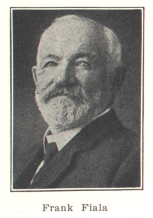
The Czech colony here covers parts of both counties. In April, 1878, Frank Fiala (born in 1843 in Horelice, living in Ravenna) came to Omaha from his home in Iowa City, Iowa. At that time much was being written about Nebraska, especially by John Rosicky, who in his weekly Pokrok Zapadu urged his countrymen to hasten before all the good lands were gone. V. L. Vodicka was also active as land agent for the Burlington & Missouri Railroad Company. Fiala knew Rosicky personally and upon his advice and that of Edward Rosewater he went to Sherman County with Vodicka. From Kearney they went by team to inspect the land, getting as far as Loup City in Sherman County. Then Fiala went to Grand Island and had plats made of Township 11, there being still plenty of unsettled lands. Upon his return to Omaha he conferred with Rosicky and Rosewater about founding a Czech colony. He returned to Iowa City and told his friends to read what the Pokrok Zapadu would have to say about his trip and the lands, and in two weeks set out with his stepfather Joseph Horak (born in Horelice near Unhost) and brother-in-law Vaclav Novy (born in Vsenice, near Rokycany). They took claims in Sherman County, a mile from the boundary of Buffalo County, in which latter county lies the large Czech colony, the town of Ravenna being its center. Settlers came slowly at first, in spite of the fact that Fiala continually published communications in the Pokrok Zapadu regarding the opportunity. At that time the Otoe Indian Reservation in Gage County had been opened and Czechs turned their steps there. However, within five years the colony about Ravenna had grown to a goodly size. 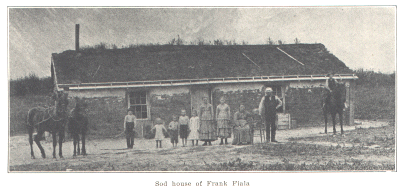 1879--The Following Came: John Horak, born in Horelice; Paul Miller, born in Mutejovice near Rakovnik; John Helebrant, born in Radnice near Rokycany; Joseph Brezina, born in Pacov, county of Tabor; B. Bugno. 1880--The Following Came: 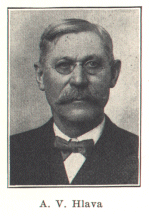
Frank, Vaclav and Cenek Kuticka, brothers, born in Stechovice, near Strakonice. These came to Buffalo County: Vaclav Hervert; Frank Vokoun, born in Slatina near Kralovice; Vaclav Skala, born in Selcany near Tabor; Vaclav Polka, born in Litohlavy near Rokycany; Fr. and Joseph Kriha, born in Viciny, near Tabor. While this settlement has never grown a great deal larger, it has always held its own and Ravenna has a goodly percentage of progressive businessmen among the Czech nationality. Czechs live and used to live in the vicinity of the following towns or postoffices: Ravenna, Rockville, Pleasanton, Nantasket (first named Trocnov, in honor of the birthplace of the famous Hussite warrior Zizka), Gibbon, Luce and St. Michael. Madison County--1878This also is a county of smaller settlements. 1878--The Following Came: John Duchacek, being the first, born in Jehnedi, Litomysl; John Dvorak, Mlaka, Trebon; Vaclav Vanek, Cijevice, Kralovice; Vaclav Skala, Poricany, Cesky Brod; Joseph Danek; Vaclav Benes, Breznice, Pisek; Joseph Dudek, Marovec, Nova Kdyne; Vaclav Skala settled in Madison, where he plied his trade of tailor. John Skala took a homestead near Battle Creek. In the early eighties, through the efforts of V. L. Vodicka, a larger settlement was effected, one of the first to come, in 1881, being Joseph Storek, born in Male Pritocno, Unhost. Czechs live in and around Madison, Newman Grove, Norfolk, Hale and Chloe (the two latter have been discontinued as postoffices). Custer County---1878The first Czechs here settled in the Elm Creek valley, south of Ansley. Among them were: 1878--The Following Came: Joseph Jelinek, born in Samikovice, Moravia. He came to Saunders County with his parents in 1871. 1879--The Following Came: John Kulhanek. 1880--The Following Came: Anton Dobes, born in January 13, 1861, in Rouchanovy, Moravia. He came with his parents to Butler County in 1871. In 1879 he selected a homestead in Custer County, making several trips by wagon to and from there. His nearest neighbor was four miles away, Kearney the nearest town. He became well-to-do and prominent and is living in Ansley. 1881--The Following Came: Frank Kohl, born in Kolnice, Moravia, in 1837, living on homestead; Frank Dobes, brother of Anton, living in Ansley. 1884--The Following Came: Anton Fortin. 1885--The Following Came: Joseph Bubak and Joseph Hromas. 1889--The Following Came: Frank Tomsicek, Frank Divis and Mr. Petrik; Mr. Vincent J. Stedry, who came with his parents to Baltimore, Maryland, in 1854, from Horni Cerekev, Pelhrimov, and to Watertown, Wisconsin, in 1870, then in 1879 to Saline County (where he taught school), took a homestead in Custer County in 1883, near Broken Bow, where he lives. 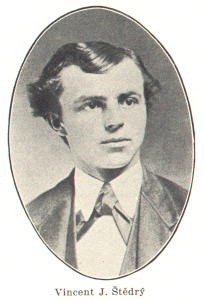
The first Czech settlers took lands east of Sargent and north of Comstock. The upper part of Mira Valley, where Czechs first settled in Valley County, is bounded by a narrow line of hills on the west. They drop abruptly to the beautiful Wood Park valley, in which place Custer County begins. This valley joins with the valley of the Middle Loup river. The northwestern part of Mira Valley, which is in reality the upper part of Turtle Creek valley, where Custer County begins, rises and forms tablelands and rough rolling country. Inasmuch as the water here is deep and hard to get, the higher lands were not taken at first and that is why the later comers, the Czechs, settled on them. The following made entry on homesteads in 1879, settled in 1880, but stayed long enough only to sell their rights to others: Joseph Gruber, who came from Kutna Hora to New York in 1872, to Howard County in 1878. His sons Anton and Frank; Anna Cizek, who came also from Kutna Hora to New York in 1871, to Howard County in 1878; Joseph Zurek came in 1880, but he stayed; Ondrej J. (Andrew) Krikac came in 1881. Born in Luzany near Prestice. 1882--The Following Came: Martin Veverka, born in Tecice, Rosice. He used to walk to Omaha to work, his family living on the claim, which lay high up and he had to haul water a great distance, or use surface water in ponds. He helped to build on his farm one of the deepest wells in that part of the country, 204 feet. Thomas Stone dug it. Joseph Krbel, born 1837 in Hluboka, County Brno, died in Omaha in 1923. He had a well 205 feet deep on his farm. Frank Scheinost dug the first 100 feet and A. J. Krikac the remaining 105 feet. Frank Kriz, born in Lhotice. Used to walk to Omaha to work. Joseph Klanecky, born in Dolni Krupa. Came to this country in 1874, to Omaha in 1877. 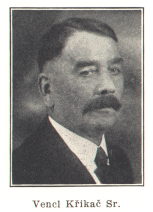
1883--The Following Came: Jacob Voracek, born in Domazlice, came to Green Bay, Wisconsin, in 1865. He came to Custer County by wagon, he and his family being nearly drowned when fording the creek northwest of Cotesfield. The horse and wagon were borne along by the current, but the animals caught hold of the opposite bank, which threw the wagon up on the ground. Vaclav Stepan, born in Horni, N. Brod. He came from Omaha, but was driven away by the drouth. Joseph Mach, born in Brtnik, Manetin. 1884--The Following Came: John Nedbalek, Lipa, Holesov; Joseph Rejda, Lipa, Holesov; Fr. Vanek, Svratka, Hradesin; Frank Vodehnal, Sec, Litomysl. Came with family to Iowa in 1876. Joseph Fajmon Jr., who came with his father, Joseph Fajmon Sr., to Saunders County in 1871. The elder Fajmon was born in Moravia. Vaclav Kluna, came with parents to Dardanelle, Arkansas, in 1877; Jacob Bursik, Tecice, Rosice. Moved to Oregon. Vavrinec Novak, Archlebov, Zdanice, Joseph Stefka. Bought homestead from Joseph Pacas. John Drobny, born in Makov in 1842. Bought homestead of Joseph Zurek. 1885--The Following Came: John Klapal, Velka Bytes, Moravia; Frank Kolousek, Zvol, Bystrice; John Penas, Dlouhy, Nove Mesto; Vaclav Hejsek, Simanov, N. Brod; Joseph Kriz, Lhotice, Namest'; Joseph Rejthard, Naloucany, Namest; James Halouska came in 1888. Born in 1845, came to Butler County in 1878. Other Early Settlers Were: Joseph Badalik, Dlouhe, Nove Mesto; Mat. Pazderka, Stritez, Pacov; Frank Chalupa; Joseph Tynsky. By 1880 all the homesteads and best railroad lands in eastern and central-eastern Nebraska had been taken and new colonies were being formed further west. They grew out of those already established, being augmented by only an exceedingly small percentage of immigrants direct from the native land. Naturally these settlements never reached the proportions of those in the eastern half of the state, where the soil is more fertile. Those who settled in the middle west, and those who later settled in the extreme west, had to struggle not only with poorer soil, but with drouth and scarcity of drinking water and timber. Western Nebraska is adapted to stock raising, and this was particularly true of it thirty years ago. Czech farmers are grain farmers and do not easily take to anything else. They tried to raise grain in western Nebraska and met with bad results. In fact, the drouths of the early nineties, especially the terrible year of 1894, drove them out in large numbers and a big percentage never returned. Our state legislature had a special session in 1894, to authorize financial aid for the farmers, so great was their suffering. Czechs in other parts of the country gathered money, clothing and provisions to help their countrymen in western Nebraska. The settlements there dwindled considerably as a result of that catastrophe, but the people who stayed and adapted themselves to the country have prospered. Boone, Boyd, Brown and Holt counties, the history of which follows, belong to the group of central-western counties; Box Butte, Chase, Cheyenne, Dawes, Hayes, Perkins, Sheridan and Sioux to the more extreme western part. The history of Garfield, Pierce, Seward, Stanton and Thayer counties comes in order here chronologically, but they do not belong to the same locality, with the exception possibly of Garfield. |
| Back | Table of Contents | Next |